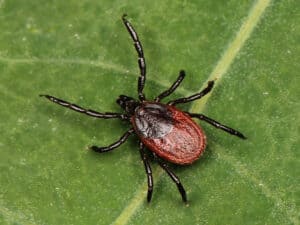8 Ticks in Arizona: Yes There Are Ticks in the Desert!
@media (min-width: 481px) {
.mobile-top-content {
display: none;
}
}
#mobileTopContentCTACarouselControls { overflow: hidden; text-overflow: ellipsis; white-space: nowrap; }
.mobile-top-content .more { color: #fff; }
.mobile-top-content a { color: #fff; text-decoration: underline; }
.mobile-top-content a:hover { color: #fff; text-decoration: underline; }
@media (max-width: 480px) {
.mobile-top-content {
background-color: #06a10b;
color: #fff;
text-align: center;
/*height: 60px;
padding-top:5px;*/
font-size:80%;
/* display: block; */
margin: 0px -30px;
}
}
The desert is often mistaken as a place with minimal life, but the Sonoran Desert that swaths much of Arizona is home to many arachnids including ticks.
The northern part of the state plays host to temperate climates and evergreen forests. It is at a much higher elevation than Phoenix to the south. Even the deserts themselves are diverse with high deserts, low deserts, mountainous deserts, and flat deserts.
As you probably know, ticks are a common vector for some nasty diseases. While the diseases that ticks carry are rare in Arizona, they’re not unheard of and are still a cause for concern. One positive is there are no recorded cases of Lyme disease contracted in Arizona.
What are 8 of the ticks living in Arizona that you will encounter? We’ll look at pictures of the most common ticks now as well as discuss some must-know details about each one.
8 Ticks Living in Arizona
These are 8 of the ticks that you’ll encounter in Arizona:
- Rocky Mountain Wood Tick
- Brown Dog Tick
- Rabbit Tick
- Winter Tick
- Western Black-legged Tick
- Bat Guano Tick
- Pacific Coast Tick
- Adobe Tick
1. Rocky Mountain Wood Tick
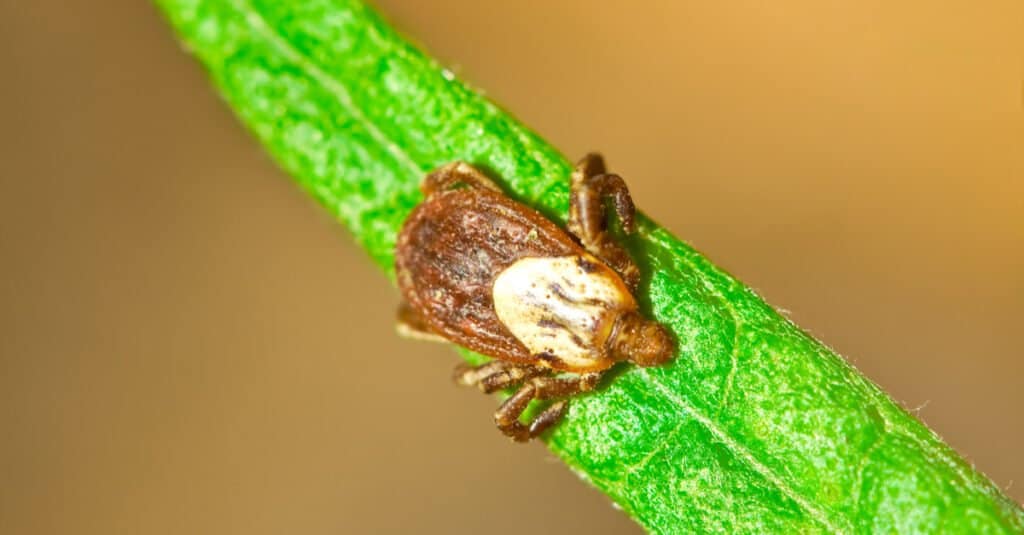
South12th Photography/Shutterstock.com
This tick is only found in the northernmost part of Arizona where brushy areas are common. They’re a known vector of Rocky Mountain spotted fever and Colorado tick fever. They’re red and females have a white design around their heads and on their backs.
Northern Arizona is at a high elevation which suits the Rocky Mountain tick as they’re rarely found below 4,000 feet.
2. Brown Dog Tick

iStock.com/Goldfinch4ever
The brown dog tick is the most common tick found in Arizona and it’s a common household pest. It is one of the few ticks on earth that can live its entire life indoors. As a consequence, it’s a pest that has infested most of the globe and it is found around the world.
These ticks will more than double in size when they’re engorged with blood. They’re usually found after they attach and feed for a few hours. They are problematic because they transmit Rocky Mountain spotted fever. However, the disease cannot be passed along to its host unless attachment has occurred for 6 hours.
Brown dog ticks are reddish-brown before they feed. If you’ve been to an area that has a known infestation of these ticks, make sure to inspect yourself carefully. They’re ruthless, spread easily, and thrive in indoor environments across the state.
3. Rabbit Tick
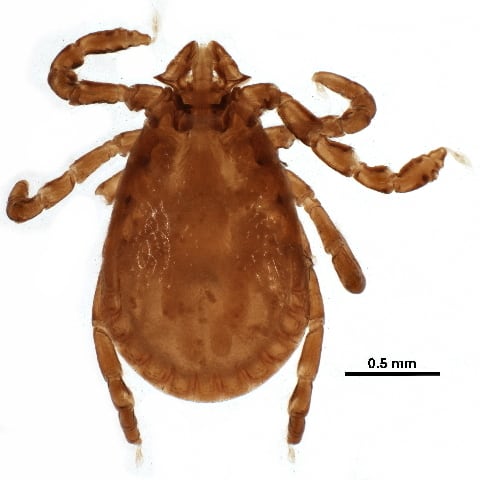
CBG Photography Group, Centre for Biodiversity Genomics / Creative Commons – License
As the name implies, these ticks primarily feed on rabbits. They’re also a known vector for Rocky Mountain spotted fever. They love arid environments and are a problem for wild rabbit populations in the Arizonan deserts.
They rarely feed on humans. Unless you’re going to handle wild rabbits and hares, they aren’t much of a concern to people. They like to feed on or near the head, ears, or eyes.
4. Winter Tick in AZ
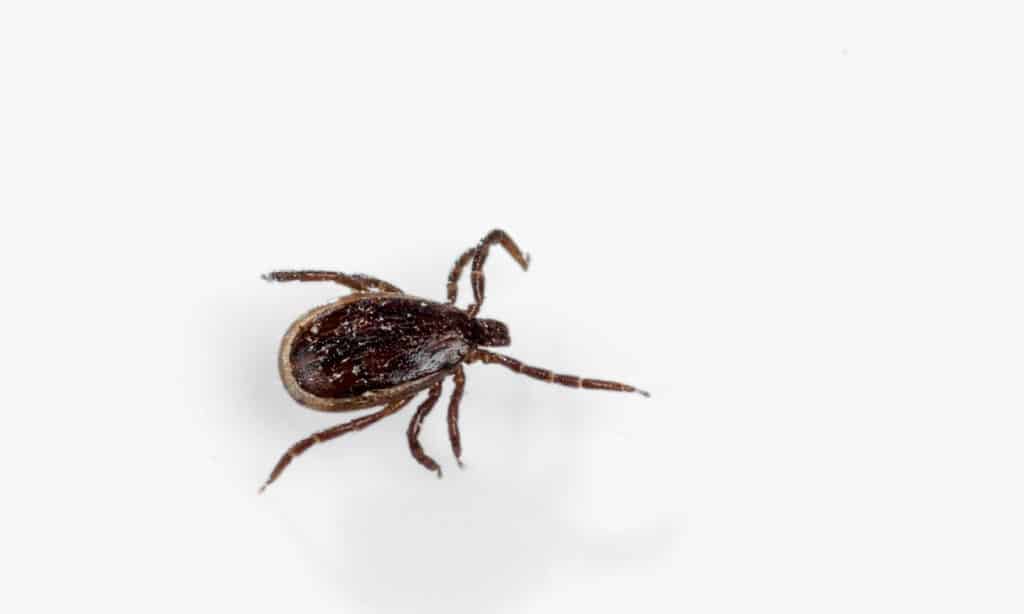
iStock.com/VladK213
The winter tick prefers hooved animals and it’s also known as the moose tick. It will go after dogs, coyotes, deer, elk, horses, cattle, and beavers but rarely bite humans. This tick has been collected in the desert, especially during the cool winter months.
5. Western Black-Legged Tick
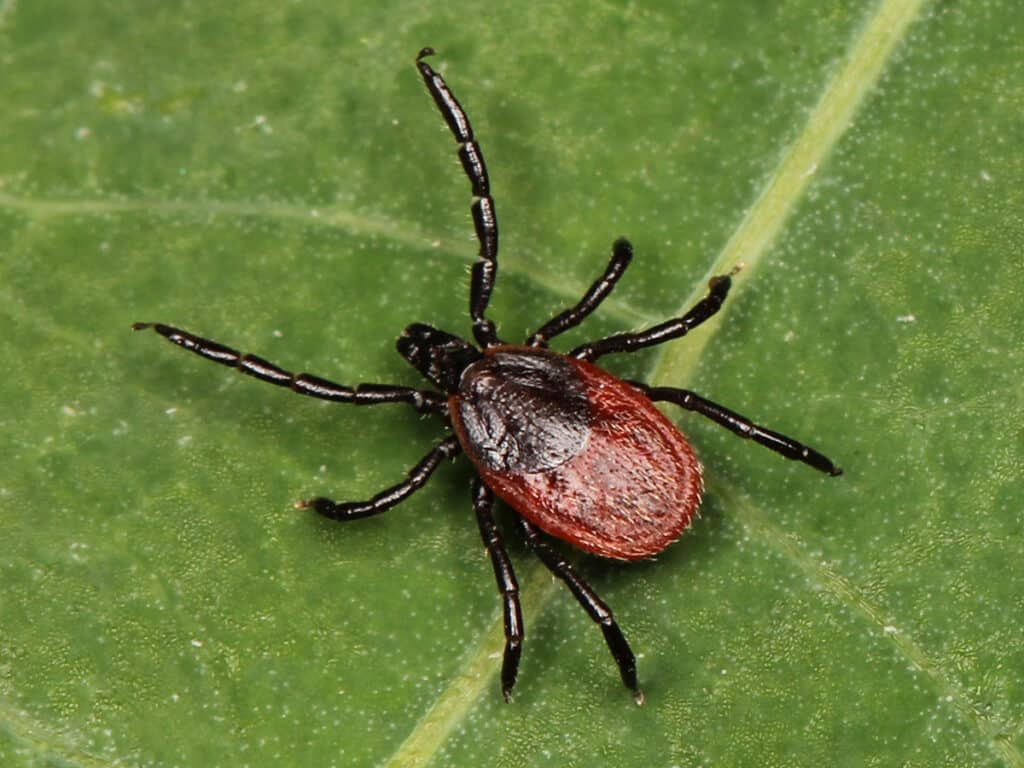
Kaldari / Creative Commons – License
This tick needs humidity so most of Arizona is uninhabitable. It is found in isolated regions to the extreme north including the Hualapai Mountains. Even then, it is only found in the spring and summer. At the higher altitudes in Arizona where its small range exists, it prefers the edge of deciduous forests. It is rarely seen in grasses or fields.
The western black-legged tick is not the same as the deer tick which is also known as the black-legged tick minus the “western” moniker. Deer ticks are not located anywhere in Arizona.
Western black-legged ticks prefer to feed on lizards and they rarely feed on humans. They carry Lyme disease, so if you’re going to their limited range, take caution.
6. Bat Guano Tick in Arizona
Arizona has seen bat guano ticks (Ornithodoros coprophilous) come in on imported bat dung from Mexico. A study was done almost a century ago to determine if bat guano ticks were present in the dung created by Arizonan bats. It was determined that they didn’t occur in the wild in Arizona though they were found in Texas.
7. Pacific Coast Tick
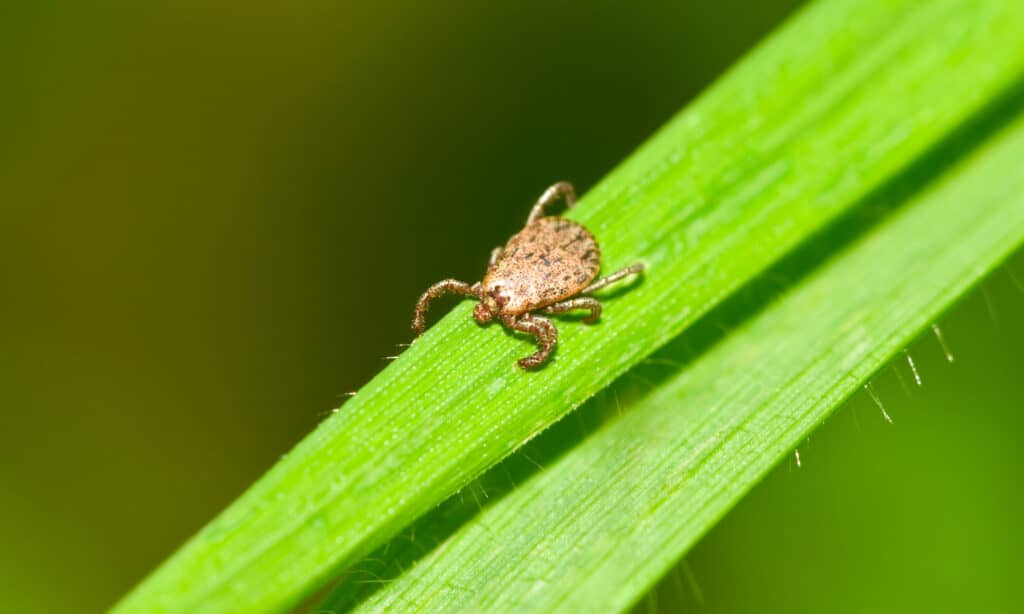
South12th Photography/Shutterstock.com
These ticks are only found in the southwestern corner of Arizona. They like large mammals like dogs and deer. They readily bite humans, so care needs to be taken if you go into their small range.
Pacific Coast ticks are especially problematic because they are a vector for a variety of diseases. Some of the diseases are Rocky Mountain spotted fever, tick paralysis, tularemia, and anaplasmosis.
8. Adobe Tick
The adobe tick is a soft tick while most of the others on this list are hard ticks. It is one of the many soft ticks found in Arizona.
Soft ticks look a lot different than hard ticks. They’re rounder, and their mouths are not distinguishable to the naked eye like with hard ticks. Their mouths are on their bellies so you can’t see them.
These ticks only need around 30 minutes to feed and their bite is painless. They prefer the nests of small mammals like rodents but any human sleeping in a structure near rodent nests will make a fine meal.
More from A-Z Animals
.more-snake-card-image { max-height:140px !important; }
@media (min-width: 481px) {
.mobile-top-content {
display: none;
}
}
#mobileTopContentCTACarouselControls { overflow: hidden; text-overflow: ellipsis; white-space: nowrap; }
.mobile-top-content .more { color: #fff; }
.mobile-top-content a { color: #fff; text-decoration: underline; }
.mobile-top-content a:hover { color: #fff; text-decoration: underline; }
@media (max-width: 480px) {
.mobile-top-content {
background-color: #06a10b;
color: #fff;
text-align: center;
/*height: 60px;
padding-top:5px;*/
font-size:80%;
/* display: block; */
margin: 0px -30px;
}
}
The desert is often mistaken as a place with minimal life, but the Sonoran Desert that swaths much of Arizona is home to many arachnids including ticks.
The northern part of the state plays host to temperate climates and evergreen forests. It is at a much higher elevation than Phoenix to the south. Even the deserts themselves are diverse with high deserts, low deserts, mountainous deserts, and flat deserts.
As you probably know, ticks are a common vector for some nasty diseases. While the diseases that ticks carry are rare in Arizona, they’re not unheard of and are still a cause for concern. One positive is there are no recorded cases of Lyme disease contracted in Arizona.
What are 8 of the ticks living in Arizona that you will encounter? We’ll look at pictures of the most common ticks now as well as discuss some must-know details about each one.
8 Ticks Living in Arizona
These are 8 of the ticks that you’ll encounter in Arizona:
- Rocky Mountain Wood Tick
- Brown Dog Tick
- Rabbit Tick
- Winter Tick
- Western Black-legged Tick
- Bat Guano Tick
- Pacific Coast Tick
- Adobe Tick
1. Rocky Mountain Wood Tick

South12th Photography/Shutterstock.com
This tick is only found in the northernmost part of Arizona where brushy areas are common. They’re a known vector of Rocky Mountain spotted fever and Colorado tick fever. They’re red and females have a white design around their heads and on their backs.
Northern Arizona is at a high elevation which suits the Rocky Mountain tick as they’re rarely found below 4,000 feet.
2. Brown Dog Tick

iStock.com/Goldfinch4ever
The brown dog tick is the most common tick found in Arizona and it’s a common household pest. It is one of the few ticks on earth that can live its entire life indoors. As a consequence, it’s a pest that has infested most of the globe and it is found around the world.
These ticks will more than double in size when they’re engorged with blood. They’re usually found after they attach and feed for a few hours. They are problematic because they transmit Rocky Mountain spotted fever. However, the disease cannot be passed along to its host unless attachment has occurred for 6 hours.
Brown dog ticks are reddish-brown before they feed. If you’ve been to an area that has a known infestation of these ticks, make sure to inspect yourself carefully. They’re ruthless, spread easily, and thrive in indoor environments across the state.
3. Rabbit Tick

CBG Photography Group, Centre for Biodiversity Genomics / Creative Commons – License
As the name implies, these ticks primarily feed on rabbits. They’re also a known vector for Rocky Mountain spotted fever. They love arid environments and are a problem for wild rabbit populations in the Arizonan deserts.
They rarely feed on humans. Unless you’re going to handle wild rabbits and hares, they aren’t much of a concern to people. They like to feed on or near the head, ears, or eyes.
4. Winter Tick in AZ

iStock.com/VladK213
The winter tick prefers hooved animals and it’s also known as the moose tick. It will go after dogs, coyotes, deer, elk, horses, cattle, and beavers but rarely bite humans. This tick has been collected in the desert, especially during the cool winter months.
5. Western Black-Legged Tick

Kaldari / Creative Commons – License
This tick needs humidity so most of Arizona is uninhabitable. It is found in isolated regions to the extreme north including the Hualapai Mountains. Even then, it is only found in the spring and summer. At the higher altitudes in Arizona where its small range exists, it prefers the edge of deciduous forests. It is rarely seen in grasses or fields.
The western black-legged tick is not the same as the deer tick which is also known as the black-legged tick minus the “western” moniker. Deer ticks are not located anywhere in Arizona.
Western black-legged ticks prefer to feed on lizards and they rarely feed on humans. They carry Lyme disease, so if you’re going to their limited range, take caution.
6. Bat Guano Tick in Arizona
Arizona has seen bat guano ticks (Ornithodoros coprophilous) come in on imported bat dung from Mexico. A study was done almost a century ago to determine if bat guano ticks were present in the dung created by Arizonan bats. It was determined that they didn’t occur in the wild in Arizona though they were found in Texas.
7. Pacific Coast Tick

South12th Photography/Shutterstock.com
These ticks are only found in the southwestern corner of Arizona. They like large mammals like dogs and deer. They readily bite humans, so care needs to be taken if you go into their small range.
Pacific Coast ticks are especially problematic because they are a vector for a variety of diseases. Some of the diseases are Rocky Mountain spotted fever, tick paralysis, tularemia, and anaplasmosis.
8. Adobe Tick
The adobe tick is a soft tick while most of the others on this list are hard ticks. It is one of the many soft ticks found in Arizona.
Soft ticks look a lot different than hard ticks. They’re rounder, and their mouths are not distinguishable to the naked eye like with hard ticks. Their mouths are on their bellies so you can’t see them.
These ticks only need around 30 minutes to feed and their bite is painless. They prefer the nests of small mammals like rodents but any human sleeping in a structure near rodent nests will make a fine meal.

